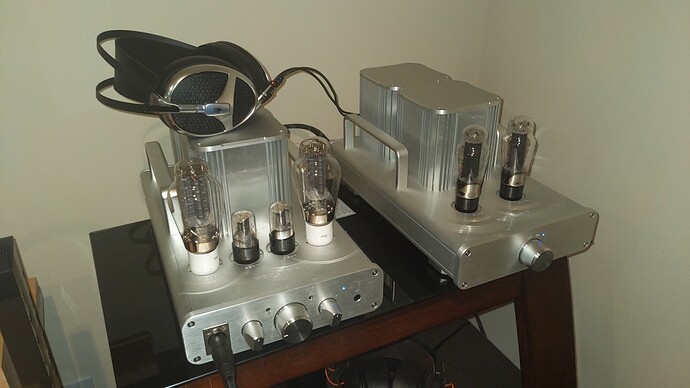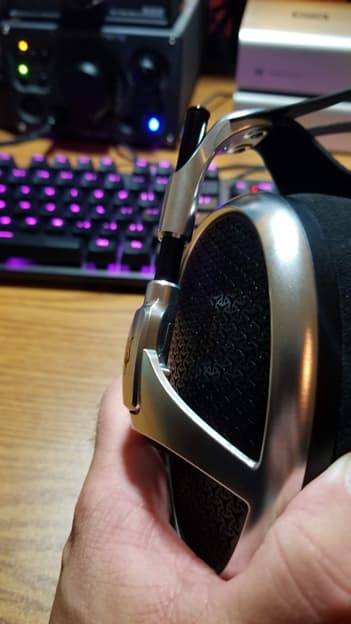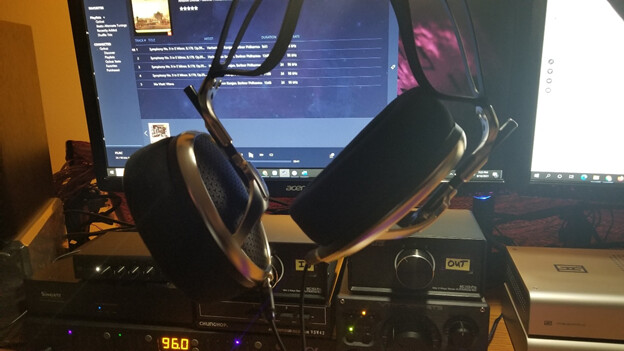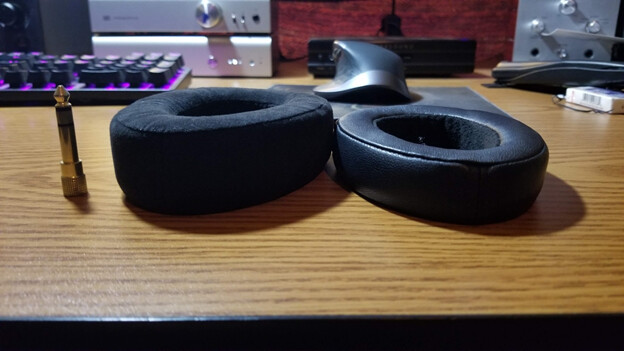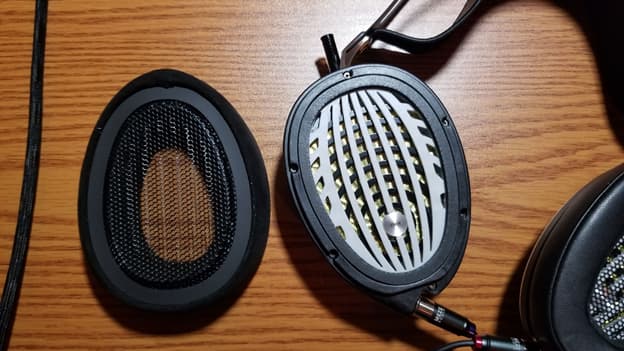Little head porn
That’s pure porn. Stop it, there should be a NSFW tag.
Juicy. Yum.
INTRODUCTION
The Empyrean Elite, the new, open-back, top-of-the-line, “Isodynamic” planar-magnetic -driver headphone from Meze. It’s $4000 US and stirring up lots of conversation and buzz. It’s indeed intriguing. It has some strengths. It has some weaknesses – as all audio components do. What are they? Read on to find out…
Get comfy, though. We again have a lot of ground to cover…
I should also get out of the way that I have not heard the original Empyrean. Therefore. the thoughts that follow will not be any sort of comparison to the original Empyrean, but a review of the Elite on strictly its own merits.
TL;DR
The Empyrean Elite has top-notch build quality and some ergonomic features that show a high attention to detail, and world-class comfort. It comes with two pad types that give meaningfully different sound signatures but also bring their own drawbacks. Trying to solve the drawbacks of one with EQ brings back the problems of the other. In the end, for many there will be a few too many sonic compromises as the overall technical sound performance is not on par with other $4K headphones, and indeed can be had for $3K.
KNOW YOUR REVIEWER
My preferred genres are rock/metal and classical/orchestral music. I’m getting to know jazz more and enjoying quite a bit. I also listen to some EDM and hip-hop. My hearing quirks include a high sensitivity to midrange frequencies from just under 1KHz to around 3Khz, give or take. My ears are thus quick to perceive “shoutiness” in headphones in particular. I describe “shoutiness” as an emphasis on the ‘ou’ sound of ‘shout.’ It’s a forwardness in the neighborhood of 1KHz and/or on the first one or two harmonics above it (when I make the sound ‘ooooowwwww’ into a spectrum analyzer the dominant frequency on the vowel sound is around 930Hz, which also means harmonic spikes occur again at around 1860Hz and 2790Hz). In the extreme, it can have the tonal effect of sounding like a vocalist is speaking or singing through a toilet paper tube or cupping their hands over their mouth. It can also give instruments like piano, but especially brass instruments, an added ‘honk’ to their sound. I also get distracted by sibilance, or sharp ‘s’ and ‘t’ sounds that can make ssssingers sssssound like they’re forssssssing esssss ssssssounds aggresssssssively. Sibilance does not physically hurt my ears nearly as quickly as shout, though. It’s distracting because it’s annoying and unnatural. Finally, I’m discovering that I have a preference for more subtle detail. I like good detail retrieval and hearing what a recording has to offer, but I prefer what many would consider relaxed and subtle rather than aggressive or detail-forward. To my ear, more subtle detail-retrieval sounds more realistic and natural than aggressive, detail-forwardness. There is a balance here, though, because detail retrieval can get too relaxed and that can sound unnatural, as well, or simply leave out important aspects of the recording. Readers should keep these hearing quirks and preferences in mind as they read my descriptions of sound.
FEATURES & BUILD
BUILD
Let’s start off with the build quality and visual stuff. It’s of course subjective, but if you can’t at least respect the build quality and the attention to detail put into the fit ‘n finish of the Elite, then you’re wrong ;p. The aesthetic design is unique and bold. It works for me – I think it’s gorgeous – but the overall beauty is definitely a matter of perspective. However, from a visual standpoint it looks – and I’ll add feels – every bit the part of a $4K headphone.
Some of the aesthetic design is also a result of form following function. The oddly shaped suspension strap allows the strap to conform to the head and alleviates common headphone pressure points. For my head it works. It’s one of the most comfortable headphones I’ve worn.
The earcups are attached to the headband with a friction-based rod and sleeve system that strikes a great balance between being tight enough to stay in place but also loose enough to adjust for larger heads. There isn’t a locking mechanism but I never had issue with the headband elongating when I didn’t want it to:
The earcups can also rotate 360 degrees:
This ability to rotate does not feel sloppy at all. You have to be intentional to move it to that position, but the balance between resisting that motion and moving it there feels wonderful.
There is dual cable entry with mini XLR jacks on each earcup. I mostly used the stock cable, which is of reasonable quality but a bit on the stiff side. It doesn’t tangle, but is prone to kinking, and a little long for desktop use. It’s probably fine for stretching from an equipment rack to an easy chair.
And then there’s the pads! The Elite ships with 2 pair of earpads. One pair is a leather hybrid and the other velour:
This ability to rotate does not feel sloppy at all. You have to be intentional to move it to that position, but the balance between resisting that motion and moving it there feels wonderful.
There is dual cable entry with mini XLR jacks on each earcup. I mostly used the stock cable, which is of reasonable quality but a bit on the stiff side. It doesn’t tangle, but is prone to kinking, and a little long for desktop use. It’s probably fine for stretching from an equipment rack to an easy chair.
And then there’s the pads! The Elite ships with 2 pair of earpads. One pair is a leather hybrid and the other velour:
The velour pads are much deeper:
Those listeners with ears that stick out may have some issues with their earlobes touching the inside of the driver housing. The velour pads have slightly less ear area but much more ear depth. Both sets of pads are soft and feel nice against the side of the head. The pad mounting system is very simple and very elegant. The pads are simply held on by magnets:
Along the theme of excellent overall build quality, the strength with which the pads affix to the frame strikes a great balance between being easy to change and holding firmly in place. This is the quickest and easiest pad swapping I’ve ever been able to do on any headphone. The Abyss Diana Phi has a magnetic pad-mounting system but that one is far more difficult to get the pad off the cup – almost having to pry it off – but the Elite lacks the Diana’s ability to rotate the pads for different sound signatures. That said, the Elite’s different pads come with sonic differences as well, which will be discussed at length in the Sound section.
What Is This Isodynamic Driver Business?
The drivers in the Elite are made by a company called Rinaro. Meze/Rinaro calls the driver a “Isodynamic Hybrid Array”. It’s a planar magnetic driver that has the wire trace built in 2 different geometric patterns in different regions of the membrane:
[Image from Meze’s website: Meze Audio Elite Aluminium - High-Fidelity Premium Open-Back Planar Magnetic Headphones]
The top part of the trace (blue) is called the “switchback” and the bottom part (orange) is called the “spiral”. The switchback is optimized for bass frequencies and the spiral is optimized for mids and highs and is also positioned to be aligned with the opening of the ear canal. In reading their website, Meze/Rinaro did not say exactly why they did this (at least on the Elite’s homepage, it may be written elsewhere), but I suspect this is done for much the same reason that loudspeakers often have multiple drivers. The laws of physics being what they are, it is very difficult to optimize one transducer to reproduce the whole audible frequency spectrum of 20 Hz to 20 KHz. So, multiple drivers are employed, each built and tuned to optimize a portion of the audible frequency spectrum. In a loudspeaker, most multi-driver speakers will have a crossover network to filter out unwanted frequencies from each driver. Here in the Meze Elite, I see no crossover (at least not that Meze is willing to show). It’s the geometry of each trace that does the optimizing. It also means that the Isodynamic driver is NOT a two-way driver in the same way that a two-way speaker is. There is one vibrating diaphragm that has the two trace geometries (again, that I can tell from pictures, I haven’t taken this unit apart because it’s a loan!). The whole driver will produce the whole frequency range, but the spiral will handle the mids and highs better and the switchback will handle the lows better. This dual-trace-geometry system functions something like a 2-way driver design but without having to have multiple drivers. This approach also brings in a new batch of problems to solve beyond what already exist with a planar-magnetic driver. With different areas of the membrane optimized for different frequencies and built different distances from the ear, phasing, time alignment, and wave superposition all become factors in ways that aren’t present in more traditional designs. Here’s a quick reminder on what wave superposition is:
https://www.youtube.com/watch?v=blur0MemUQA
Multi-driver designs are rare in headphones because the inherently limited space makes it very difficult to correct for those things. With loudspeakers and the listener sitting feet/meters from the speaker, it’s much easier. How well did Meze/Rinaro solve those issues? Well, that’s where we get to talk about…
SOUND
Test Gear
My high-end signal chain, and where the Elite spent the most time with me, is a Berkeley Audio Designs Alpha S2 DAC and a Violectric HPA-V281 headphone amp. The Alpha S2 is connected via AES to a Singxer SU-2 DDC and USB interface, which is in turn connected to a Windows 10 desktop computer. Audirvana 3.5 is my primary music app for critical listening, playing lossless and hi-rez local FLAC and DSD files, and streaming lossless/hi-rez FLAC from Qobuz. The Elite spent some time being driven directly by my Chord Hugo 2 transportable DAC/amp connected to my Cayin N6ii DAP via Cayin’s USB-C-to-coaxial digital interconnect cable.
Sonic Traits Regardless of Pads
Regardless of which pad type you choose, the Elite gives a sonic presentation that is more relaxed and smooth. There is reasonably good detail retrieval but the resolution and detail is not forward. The intent seems to be listenability over long periods of time. The soundstage is also big. The soundstage is reminiscent of HiFiMan’s line of egg-shaped planar-magnetic headphones where there is a grandiosity to the since of scale. The Elite isn’t quite as extreme as an Arya in that regard, but it’s on the bigger-than average side, with most of the staging happening out in front, as opposed to a Focal or Audeze-like bubble around the head. The treble is also sparkly and clean with good detail and timbre regardless of pad type. It’s in the overall frequency response, the qualitative aspects of the mid-range and bass, and imaging-separation where the differences in pads become audible. Let’s explore each pad type.
Leather Pads
The overall sound signature with the leather pads leans warm. There is good bass extension and punch/slam and good low-end pitch definition. The bass doesn’t seem to roll off, being nearly as present at 30Hz as 100Hz. The mid-range is also pleasantly present. The FR is overall neutral, but with that warmer tilt. Overall, I prefer the frequency response tuning of the leather pads over the velour. But there are some issues here…
The first issue with the leather hybrid pads is that there is a noticeable veil. When I first put the Elites on, I was struck but the pleasantness of the tuning, the warmth, the soundstage size, and general smoothness, but there was also something missing. It took me awhile to figure out what it was but there was a veil in the lower half of the mid-range, that gave the lowest registers of female vocals and the lower half of male vocal frequencies an odd muddiness. That impression usually faded after 30 seconds or so but would again become noticeable after returning from every listening break, and became nearly impossible to hear around or through when I started A/B-in the Elite with other hi-end headphones.
This veil also appears to affect the imaging. Sonic images are placed well but the separation between them is not what I would expect for $4K. The depth also appears to be somewhat compressed with the leather pads.
Velour Pads
With the velour pads the lower-mid-range veil almost entirely fades. If I ear-squint, I sometimes think I hear it, but I have to work really hard to do so. The sound signature with the velour pads tilts neutral-bright with very crisp and airy treble. They also dramatically improve the imaging and separation, creating a much more convincing and believable spatial presentation than the leather pads. Problem solved, right? Not quite. The bass aggressively rolls off below around 100Hz. It’s not quite a brickwall roll-off but it’s close enough to that that it made me think of the term. Furthermore, the bass that is present sounds one-note-y, lacking in some pitch definition.
A Band of Excellence
Oddly, with each pad type there was a narrow range of frequencies where the technicalities of the Elite were amazing, it just wasn’t the same range for each pad. For the leather hybrids the frequencies around the attack sound of a kick-drum and around the upper bass sounded amazing. A track that showed this off was The Chain by Fleetwood Mac. Mick Fleetwood’s bass drum had a punchy, dynamic attack followed by a satisfying and deep whump after the initial hit of mallet to drumhead. John McVie’s bass line also had lots of great impact, pitch definition, and texture. But, of course, there was the veil in the lower half of the vocal range. Switching to the velours and the bass drum and bass line become less dynamic and punchy and the whump of the kickdrum’s body receded significantly but Fleetwood’s snare and the vocals had lots of snap, texture, and detail. Outside of each pad’s “optimal range” the performance was usually good but there were those veils for leathers and bass roll-off for the velours.
But What About Equalization?
Yeah, so I figured it was worth a shot a try a bass boost with the velour pads. That should bring the bass back in and keep the veil at bay. That way I could have my cake and eat it too – it is $4000 cake, after all. I’m not a huge fan of EQ, but I wondered if it would help here. I first tried the Sonimus Free EQ VST 3.0 plugin (SonEQ – Sonimus) for Audirvana 3.5 and added in about a 4dB boost at 30Hz. The bass boost worked! The punch and rumble came back, still not a lot of subbass texture, but the presence and slam returned. But, hello veil! Yeah, that veil in the lower half of the vocal range came back. Now, the Sonimus EQ is the free version and it introduced some midrange grain before when I used it with the Audeze LCD-24 several months ago so I thought maybe the veil returning was mostly because you get what you pay for and it was free. So, I busted out my Schiit Loki and gave it a quick listen with it in between my Alpha S2 and V281’s SE connection without any EQ active to make sure it didn’t introduce any artifacts of its own. As best I could tell, the Loki was clean as can be. I then tried an additive EQ by boosting the bass knob to around 2:00 (its 12:00 position is the +/- 0 position) and left the other knobs at 12:00. The bass started to come back, but that veil also started to come back. Turning that knob to 3 and then 4 and the bass got fuller and punchier, but then so did the veil! Past 4:00 and the bass just went sloppy altogether as the driver was being overdriven. OK, next I tried a subtractive EQ by leaving the bass knob at 12:00 and turning all the other knobs down to 9:00. VEIL! Even stronger than the additive EQ!
A Thinly Veiled Hypothesis
There are two issues coming together to create this veil, I think. It seems to be correlated with the relative levels of bass frequencies to the rest of the frequency spectrum. Then, the Rinaro Isodynamic driver in the Elite places the regions that emphasize different ranges of the audible frequency spectrum at different distance from the ear opening. The bass-emphasizing region is farther away. This creates a time alignment issue in getting all of the sounds to reach the ear at the same time, which can create some phasing oddities. I think what’s happening with this veil is that bass frequencies are interfering with mid-range frequencies in such a way that it’s creating an audible loss of clarity in the lower mids. There is a combination of constructive and destructive wave interference that’s happening because the time alignment of the two driver regions are off and the resultant waveform that reaches the ear is a bit dodgy in the lower-mids. And the more bass there is in relation to the rest of the frequency range, the worse the effect gets until the driver just flat bottoms out and can’t produce any more bass without distorting on its own. Similar effects can be heard – although not always in the lower mids – when you sit too close to a 2-way speaker that isn’t designed for near-field listening. Back up, where the makers intended the listener to be, and the design of the speaker takes into account that time alignment and the speaker sounds normal again. I’m sure Meze is aware of this issue and attempted to do something about it but hasn’t yet succeeded. Doing so in the limited space of a headphone is certainly a challenge. I am very interested to see if they can solve this going forward.
COMPARISON WITH THE HIFIMAN HE1000v2
My other hi-end planar headphone on hand is the HiFiMan HE1000v2, or HekV2 for short. It costs $3000US new and can often be found used as low as $1500. Its signature is more v-shaped than the Elite with either pad type but it is also a more warm, relaxed, smooth-presentation headphone.
The Elite definitely has more mid-range presence than the HekV2, with either pad type, but I give the edge to the HekV2 in mid-range timbre. The Elite has slightly better treble timbre, I think, but not any noticeably better detail retrieval in the treble. The HekV2 has more present subbass than the Elite with either pad type, but that was doubly or triply true when the Elite had the velour pads on. With the leather pads the Elite punched harder than the HekV2 did between 100 and 200 Hz, but the HekV2 punched harder below 100Hz. The HekV2 also had noticeably superior subbass texture where the Elite with leathers had better texture in that same 100Hz-200Hz range.
As far as detail retrieval goes, it was in the comparison with the HekV2 that I noticed the Elite’s tendency to have a narrow band of frequencies where it was amazing but then fall off outside of that range. Two tracks really brought this out. The first is Afraid of Time from the Interstellar Soundtrack and the other is Pain by The War On Drugs. In Afraid of Time there is a piano played one key at a time. However, there is also something else happening simultaneously with each key strike. There is a muted xylophone or a plucked and muted string-based instrument of some sort that’s striking/plucking right with the piano key hits. In my initial A/B I had the leather pads on the Elite. I was actually listening to Mountains , the track immediately preceding Afraid of Time to check for dynamic range differences (none that I could tell on that, btw) and then this track came on. I was wearing the HekV2 when I went to jot down my notes. The HekV2 showcased the wooden sounds of the piano’s mechanical action, resolved the reverb, and that simultaneous low-level striking/plucking sound. The Elite with leather pads comparatively struggled. It was not nearly as clear or clean on those sounds. Switching to the velours though and that resolution and clarity were arguably just slightly better than HekV2, but only just barely.
On the track Pain , which has a very active bassline, the Elite would have that great bass texture above 100Hz, but as soon as that bassline walked below that level, the tone would still be present but the texture would all but vanish. The HekV2 maintained the same level of texture it had above 100Hz all the way down as deep as that bassline would go. It was also this track that helped me figure out that the veil on the Elite was happening in the lower half of the male vocal range as the lead singer’s voice was definitely veiled on the leather pads and with the bass boost EQ until he would hit higher notes, where suddenly it would become clearer again.
Here’s the takeaway here: the Elite, at $4000, is not clearly technically superior to the HekV2 at $3000, throughout the entire 20 Hz to 20 KHz audible range. There are some brief windows where it is superior, but they are small and infrequent. On the whole range of technicalities – resolution, extension, dynamics, timbre, soundstaging, imaging & separation – the HekV2 actually outperforms or is dead even with the Elite more than the Elite outperforms the HekV2, and I can’t think of an example where the margin by which the Elite is the better performer is larger than the margin by which the HekV2 is the better performer. There are signature differences, notably in midrange presence, where some listeners will simply prefer the tuning of the Elite, but that doesn’t make the Elite better .
FINAL THOUGHTS
The Empyrean Elite has a driver that has an interesting twist on how to reproduce the entire audible frequency spectrum. That driver tech introduces its own set of challenges, and to my ear, the Elite has not overcome all of those challenges. With the included pads one has to choose between a veil in the lower mids or an aggressive bass rolloff below 100Hz. That veil appears to come back if the levels of bass are adjusted higher, either with a boost or by attenuating everything else. Furthermore, the overall technical performance doesn’t decisively better, and in many cases lags behind, a well-known headphone that cost 75% of the Elite’s asking price. That aside, the build quality and fit ‘n finish are spectacular. There is a pleasing and generalist sound signature that plays nice with a wide variety of musical genres and many will still find much to like about the elite. I’m hoping that Meze is able to sell enough of these that they can take another meaningful crack at solving what I think are some phasing issues creating that lower mid-veil.
Thanks for reading all! Enjoy the Music!
![]()
That was an astoundingly fair and honest take! Bravo to you sir. Great review.
I’d like to see you review the Empyrean and compare them. You write well  .
.
From what I can see, neither the Empyrean nor the Eilte has good price to performance ratio. In fact, Crinacle has given the original Empyrean a B+ only, whereas he gave the HE1000V2 a S- (S>A>B)
@John_William and @CarpentersFan thanks for the kind words. @CarpentersFan, I likely won’t get around to Empy OG anytime soon. Lots on the plate right now with more incoming!
Happy weekend friends!
This video will share my impressions on the MEZE Elite from Meze Audio and Rinaro Isodynamics. This video will focus on the build quality, design, and some of my sound impressions about the Elite comparing them to the Audeze LCD-5 , and Final Audio D8000 with pro pads using several different headphone amplifiers such as the Chord Hugo TT2, Audio Research I/50 integrated tube amplifier, ampsandsound Agartha tube amplifier, the McIntosh MHA200 Headphone tube amplifier, Chord Hugo 2/2go, and the Astell & Kern SP2000T.
I hope you enjoy it! Marcello
